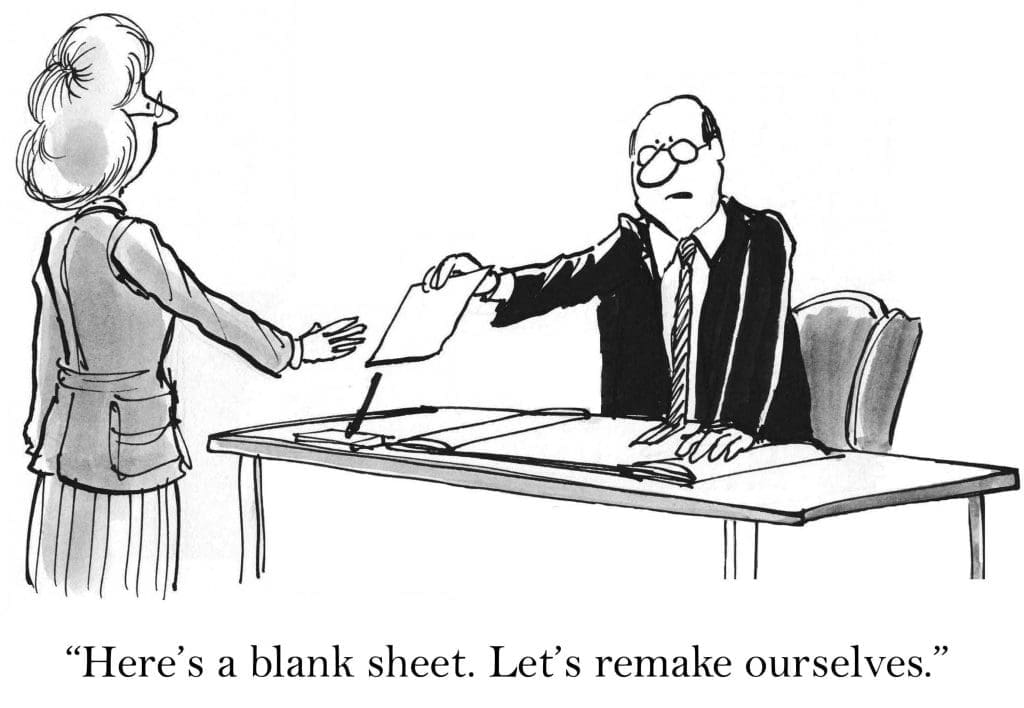At a recent workshop, I spoke to a roomful of Human Resources directors about Blue Ocean Strategy® and how it was relevant to their roles in organizations that are changing. Their biggest challenge, they said, was less about adapting their strategies or enabling their organization to execute on new strategies. Rather, each of them had been given the job of changing the corporate culture. That was their strategy if the organization was to capture new customers and sustain the ones they had.
Assuming that meant there was a connection between business strategies and corporate culture, they were doing important work. Their challenge was the articulated disconnect between the changes taking place in the organization and the demands upon them to manage the culture.
Why, I asked, is changing corporate culture in the hands of human resource directors alone? And what does it mean to really change an organization’s culture?
Their companies ranged from mid-market engineering firms to large retailers and pharmaceutical companies. Yet from all corners of the room, I heard the same refrain: corporate leadership had told them it was their job to change their organization’s culture while at the same time, onboard a new generation of employees and meld them into the current culture or even the new culture—they weren’t sure which. No doubt, this was quite a challenge.
Their corporate situations were varied: one was the product of a merger; a second was growing organically and recruiting new, young professionals; a third was dealing with shrinking revenues and seeking more productivity; a fourth was tasked with changing the culture and making it more innovative; and the rest were indicative of the range of challenges facing human resources and their companies across the U.S. today. But at the end of the day, they were all facing the uphill climb of changing the behavioral foundations of their companies. And, as I saw in their faces, they were all tired, frustrated and struggling.
Is HR now the bearer of good and bad news about company culture change?
Where to begin? First, in the workshop we worked on why these Human Resources directors, and so many of their colleagues, were now key figures responsible for changing their company’s culture. Why was this delegated (or abdicated) to their departments?
As intelligent individuals, they knew that changing a culture was hardly a simple “task” to be done. It was the essence of the organization, the way the company did things. They current clients counted on them to be that company — but were they? Who was going to be their customer in 3 years and did their current culture enable them to capture them?
But how could one department enable the entire organization to shift its values, beliefs and behaviors—along with the symbols and rituals that support them—to a new set of cultural elements that could better position that company for a new set of goals or achievements?
Tellingly, the literature in Human Resources journals speaks widely on this critical role. For example, the outstanding article, “HR Impact on Corporate Culture,” from HR.com (2005) states, “Because culture is so important to the success of a firm, human resource professionals need to increase their proficiency at impacting culture. Ask an HR leader to describe their employer’s culture and most will provide an insightful answer. Responses like ‘team orientated,’ ‘performance-driven’ and ‘family atmosphere’ might be some common responses. However, ask this same HR leader to articulate their role in shaping corporate culture and their responses become a bit vague. The reason is that few terms have been more ignored or misunderstood by human resource professionals than corporate culture.”
HR professionals have control over many of the tools needed to impact, and change, a culture.
These include, of course, pay systems, performance management, recruiting and selection, and staff development. These tools are crucial to ensuring the organization is recognizing and reinforcing the values, beliefs and behaviors it wants to encourage and penalizing those it wants to stop. But to think that a culture can change by changing these forces is putting the cart before the proverbial horse.
What is a corporate or business culture anyhow?
Culture cements an organization’s employees to its values, norms, stories, beliefs and principles, and incorporates these assumptions into their activities and core sets of rules and standards. Not only that, a company’s culture enormously impacts its overall effectiveness and quality of its product and services. MIT’s Edgar H. Schein in his article, “Culture: The missing concept in organizational studies,” defined organizational culture as a dynamic force. He was surprised by how little we actually knew about culture and also how little it was being studied ethnographically in order to better understand corporate-specific cultures.
As we know from the work of Cameron and Quinn, authors of the influential book “Diagnosing and Changing Organizational Culture,” successful organizations have cultures that are consistent and commonly shared across the institution, even when there are modifications in departments. Culture isn’t just “stuff.” It is shaped by the employees at all levels through the meanings imparted to symbols, gestures, behaviors and attitudes. These basic patterns of shared assumptions, values and beliefs become the “correct” way of thinking about and acting on problems and opportunities. It is what is important and unimportant in the organization.
Another way to think of culture is as an organization’s DNA. Like DNA, it is largely invisible and seems to just “happen.” Yet it is a powerful foundation shaping what happens in the workplace.
Its importance stems from the power it holds over how people work together—and live together. The ability of a strong, unique culture enables a company to:
- Reduce collective uncertainties
- Create a social order with clear guidelines for what is expected
- Develop the continutiy to perpetuate key values, norms and beliefs across successive generations of employees
- Build a strong shared identity
- Develop the committment that binds people together
- Most of all, craft a clear vision of the future to energize the efforts needed to get there
But why is culture change being laid at HR’s feet?
Here are three answers to that question shared by the HR directors that day:
- If “culture eats strategy for lunch,” or so we are told by Peter Drucker and his followers, it is clearly very important. But it is also very difficult to focus on culture when management is busy running the business. So it becomes the HR director’s job. Hand it off and tell those HR folks to get it done. A big disconnect? You bet.
- In all too many cases, companies don’t really know what their culture is today, much less what they want it to become in the future or how to get it there. Why is it good or bad now? How does leadership know that a new culture will be right for the jobs to be done in the future? Let it be HR’s job to figure out the current culture and develop the skills needed to change it. Then, they can be the experts in the transformation process.
- The central role of culture is to create a shared, predictable way of doing things so people can get through each day with an understanding of what “matters.” It is not just what they are doing, it is why those activities “mean something.” This meaning applies to themselves, others they work with, their customers on the outside and the communities in which they live. It is hardly mindless or easy to ditch for another flavor—much less one that is untested and uncertain. But building the rituals and symbols to reinforce desired behavior can really become part of the HR role—they just don’t want it to be part of theirs.
If a company’s leadership believes that it is a good time to assess and perhaps change the organization’s core culture, it needs a process to do so that has the legitimacy its employees expect and deserve. They are going to be challenging not just the job being done but the essence of the person doing it—which will lay bare the deep set of beliefs that are manifested in their daily habits, conversations, celebrations and irritations. This is no small task, but the learning that comes from identifying and then changing a culture is nothing less than revolutionary.
A very good article about the value of HR
You might enjoy this related article from HR Software examining how the human resources department truly is the oil that keeps a firm functioning at full capacity and optimum productivity.
Need some more reading?
In my new book, “On the Brink: A Fresh Lens to Take Your Business to New Heights,” I dig deep into these questions and show you how a little anthropology can help companies like yours better understand your culture today and how it needs to change for the future. You can download the first chapter FREE!
Could your business use a culture change?
At Simon Associates Management Consultants (SAMC), we help organizations change, grow and thrive amidst today’s changing times. Specifically, we can help you pinpoint what your company’s culture is today and what it needs to be to take you successfully into the future. If this might be of interest to you, we would like to offer you a free consultation. Please contact us!



